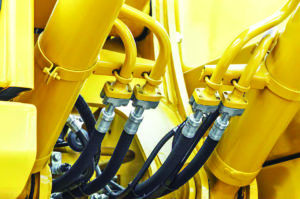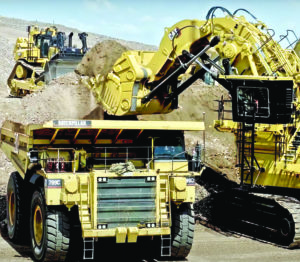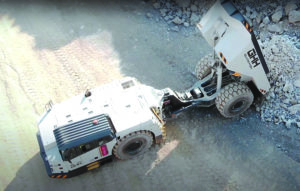
Using the right formulation of new-generation fluids for a specific application often can provide benefits beyond the conventional demands of lubrication, minimization of wear, thermal and oxidative degradation, rust and corrosion protection, and heat dissipation.
The cost of hydraulic fluid is only one variable in the equation leading to optimal hydraulic system performance. Energy conservation and environmental safety are also gaining importance in calculating a product’s real value.
by russell a. carter, contributing editor
The past 18 months have been unsettling for high-volume buyers of refined hydrocarbon products such as large-scale mining operations. Supply chain, workforce and political disruptions — sometimes individually, sometimes in combination — have nudged miners away from any notion of operational complacency amid growing concerns about the continued availability of critical consumables, rising prices for fuel and steel products, and global inflationary trends.
The cost of greases and oils is an important factor when planning maintenance budgets, and prices for those products have skyrocketed, making lubricant choices even more important. In November last year, Tom Glenn, president of the consulting firm Petroleum Trends International, explained in an online article that “…while lubricant prices have experienced ups and some downs over the years, the events of 2021 have made this year one for the record books. With two months left on the calendar, lubricant prices have increased six times — seven when the most recent increase for synthetic lubricants is included. This contrasts sharply with an average of two annual price increases from 2010 to 2020. Prior decades were similar for annual price adjustments.
“The magnitude of the 2021 adjustments has also been remarkable,” he continued. “Where price increase announcements have ranged from 6%-8% over the past 10 years — and a few percentage points lower in prior decades — the six increases announced this year averaged 14%. When taken together, the increases moved the price of lubricants up by nearly 116%, and the seventh increase pushed the price of synthetics up by about 140%. The next highest annual increase came in 2011 when lubricant prices escalated by 27%.”
The upward price trend continued in 2022. Citing a shortage of base oils and additive chemicals along with higher costs for packaging and freight, almost every large industrial petroleum supplier announced price increases of 15%-25% effective earlier this year for their lubrication products.
But rising costs are just one factor in the mix: An operation’s choice of greases and oils now might carry a much higher burden of responsibility than just dollar cost per unit. Gone are the pre-ESG, pre-pandemic days when lubrication products were simply commodities dependably delivered by pallet, barrel or tanker, then used and discarded. Consider hydraulic fluid, for example, which typically represents 8%-10% of total lubricant sales; apart from determining whether a fluid’s technical properties are appropriate for the machines and conditions in which it will be used, customers also may need to consider the interplay between product cost and potential energy-efficiency improvements gained from its use as part of a corporate decarbonization strategy, or whether it’s an environmentally acceptable lubricant product if it’s to be used in certain sensitive environments, or even whether its packaging is recyclable.
With heavy-duty hydraulics technology trending toward more precise modulation of power in smaller, more powerful and easier-to-maintain packages, hydraulic fluid formulations will have to maintain a steady pace of improvement to serve these less-is-more systems in a way that functions efficiently within the future framework of performance, energy conservation and safety/environmental expectations.

Caterpillar offers hydraulic optimization on its newest generation of excavators, which the company says saves energy by ensuring that only the minimum necessary oil flow is used at any given time during swing movement.
Pursuing Higher Performance
Manufacturers of mining-class mobile and stationary equipment continue to integrate design tweaks aimed at improving hydraulic system performance. A quick review of recent product introductions from major OEMs shows:
Caterpillar highlighted its Hydraulic Optimization features in its latest generation of hydraulic excavators — a demand-based approach providing maximum flow rate from pumps only when a task needs it.
Liebherr’s Power Efficiency (LPE) technology, which will be included as a standard feature on its Generation 7 excavators, is an engine and hydraulic management system designed to reduce fuel consumption by up to 20%. The system’s main features include electronic control of hydraulic system pressure and oil flow, along with higher-efficiency control valves and new pumps, all of which are integrated to provide better fuel efficiency without affecting machine performance.
Hitachi upgraded its newest generation of excavator hydraulic systems, incorporating a larger hydraulic fluid cooler, variable-speed fan, a refined valve-control system and contamination sensors for all main hydraulic assemblies on its latest model, the EX2000-7, for example.
Epiroc noted at the introduction of its SmartROC D65 surface drill that the new model needs far less hydraulic fluid tank capacity than its predecessor.
Volvo Construction Equipment and Finland’s Norrhydro are cooperatively developing a new technology that they predict will
revolutionize machine hydraulic performance when commercialized, offering potential benefits that are expected to be radical, with machine fuel efficiency significantly increased and CO2 emissions being cut. Although Volvo CE is closely guarding full details of the technology, it mentioned that the Norrhydro patented system, NorrDigi, uses a multi-chamber digital hydraulic actuator that improves system efficiency to the point that much of a machine’s hydraulic system can be discarded or downsized, including the need for a main control valve or excess pump capacity, piping and hoses. Because it uses less energy, it offers the prospect of downsizing engine capacity.
Hägglunds Drive Systems recently introduced the Fusion system — a small footprint, plug-and-play hydraulic drive package designed to provide users with increased flexibility for drive placement, or replacement of a mechanical system — as well as its Atom hydraulic motor, another small footprint, power-dense product that expands power-transmission choices for users such as mining customers that often have space limitations that restrict drive-unit size.

Mobile equipment manufacturers such as GHH are increasingly turning to the use of biodegradable, flame-retardant hydraulic fluids for both safety and environmental considerations.
The target of many of these hydraulic-system improvements is higher efficiency, and this is also an area where the specific formulation of hydraulic fluid can provide measurable benefits beyond just the conventional properties of internal lubrication, minimization of wear, thermal and oxidative degradation, rust and corrosion protection, and heat dissipation. In a recent webinar, Blayne McKenzie, technology manager-industrial oils at Lubrizol, explained how formulation development typically takes place:
As lubricant manufacturers begin to evaluate the specific characteristics necessary to produce an effective hydraulic fluid, they typically follow a four-step process to determine what products to move forward to production:
Laboratory studies: Testing to determine if a fluid is suitable for hydraulic applications. Researchers run multiple fluids through numerous bench tests and determine which ones are the most promising.
Performance testing: The leading candidates that make it out of the lab are then tested on proprietary rigs designed to simulate real-world conditions, but under controlled circumstances.
Equipment testing: The best performers then move on to testing in real equipment in a controlled laboratory environment. This stage eliminates some of the variables associated with real-world testing while still subjecting the fluids to in-equipment environments.
Final proof: Once the laboratory work has been done, it’s time to put the fluids into real-world equipment to see how they perform.
McKenzie noted that performance polymers are an important part of multigrade hydraulic lubricant formulations. When compared to a conventional monograde lubricant, a performance polymer can expand the safe operating range of a hydraulic system by ensuring fluidity during cold weather start ups and maintaining viscosity and protective fluid film thickness at higher operating temperatures. There are a variety of available performance polymers, each delivering different beneficial characteristics.
In laboratory tests, energy-efficient hydraulic fluids (EEHFs) formulated with specific efficiency-boosting performance polymers (EPP) have been shown to lower the traction coefficient versus a standard multigrade fluid by 9%, meaning the fluid flows more efficiently through the equipment. They have also been shown to reduce shear loss by 49%. What this means practically, said McKenzie, is that EEHFs with performance polymers, which have excellent performance in low traction/high-efficiency applications, thermal and oxidative stability and are NSF H1 approved, may demonstrate improved efficiency while keeping high levels of protection.
Once the lab tests show promise, more sophisticated testing can measure the energy efficiency across the entire system. In performance testing conditions, oil with EPP has been shown to improve efficiency by 28% and durability by more than 49%. EPPs do this by mitigating the inefficiency of secondary flows, which form in a bend or change in pipe geometry. In addition, hydraulic fluid with performance polymers also has been shown to reduce the amount of power loss.
The final step in the process is to test the fluid in both mobile and stationary applications in actual field tests. For the mobile test, the fluid would ideally be tested in summer and winter conditions to see how much fuel consumption is reduced. Fluid with the EPP could lower fuel consumption by as much as 1.4% in the summer and 2.7% in the winter.
For the stationary tests, it is possible to measure efficiency improvements by the amount of electricity used by the equipment. Fluids using performance polymers have been shown to reduce electricity usage by 8.5% over the monograde fluid usually used.
Defining Biodegradability
All hydraulic fluids consist of base oils and a package of chemical additives aimed at providing specific qualities. Suppliers and mine-equipment OEMs increasingly refer to “biodegradable” when it comes to the latest generation of hydraulic fluids. But what does it actually mean? Mobil described the category by first pointing out that there are actually two classes of biodegradability — Inherently and Readily. The company explained the difference:
The term “inherently biodegradable” is used for classification of a product that has a biodegradation rate of more than 20% in 28 days, which includes most, if not all mineral oil lubricants (up to ISO VG 320). The “readily biodegradable” classification is for a product that biodegrades more than 60% within 28 days, which precludes most, if not all, mineral oils.
The company warned that while there are numerous benefits a biodegradable hydraulic fluid can deliver — for instance, less environmental impact if the hydraulic fluid breaches containment — specific types of biodegradable ingredients can impact the performance of hydraulic oil differently. Vegetable-based fluids are generally more readily biodegradable, but may not provide comparable service life to that of a conventional mineral hydraulic fluid. Synthetic ester-based fluids, according to Mobil, deliver a more biodegradable formulation than conventional mineral oils, and can have an extended service life.
Safety is another major consideration, particularly in underground operations where fires of any kind can be catastrophic. For example, German mine equipment supplier GHH recently pointed out that the hydraulic system of its flagship MK-42 underground truck has a capacity of around 325 liters or 86 gallons: a hydraulic leak in this 42-ton-payload hauler would not only cause serious damage to the environment, but would also entail extensive cleanup measures at the site.
“We are therefore offering vehicles with biodegradable hydraulic fluids with immediate effect,” CEO Jan Olaf Petzold announced, noting that these new fluids, supplied by another German supplier, Fluid-Competence, are claimed to be highly biodegradable. Petzold pointed out an additional advantage: “Because they are flame-retardant, we also reduce the risk of accidents for the operators, machines and the production site by not allowing the flame to propagate.”
Although costs will be slightly higher, Petzold said he considered them justifiable, and the biodegradable fluids will be introduced successively for all product groups.
Fluid-Competence’S CORSAVE hydraulic fluid, specifically intended for underground use, is an HFA-type concentrate that is mixed on-site with 98% water, offering up 99% degradability within 28 days as well as superior flame resistance and corrosion protection. However, it’s only one of a large handful of recently introduced hydraulic fluid products from other suppliers that provide higher environmental and safety performance. Here are a few examples:
Mobil now offers several environmentally acceptable lubricants (EAL) that are readily biodegradable, including the Mobil EAL Envirosyn H Series and Mobil EAL Arctic series. Also, for low aquatic toxicity, users can select a zinc-free product like Mobil DTE 10 Excel Series oils.
Petro-Canada Lubricants introduced ENVIRON MV R, calling it the first hydraulic fluid using ultra-pure severely hydrotreated base oils to meet OECD 301B requirements for ready biodegradability. The new fluid, said the company, combines select, ultra-pure, severely hydrotreated base oils with a premium ashless additive system to offer the protection of a premium mobile and industrial hydraulic fluid while also being OECD 301B Readily Biodegradable.
The company said ENVIRON MV R also provides excellent hydrolytic stability, better seal compatibility than vegetable oil and ester-based products, and has the ability to perform over a wide operating temperature range, including maintaining fluidity during prolonged low-temperature exposure.
Renewable Lubricants offers its patented Bio-Ultimax 1000, stating that this Readily Biodegradable biosynthetic formula performs like mineral oil-based hydraulic fluids but is environmentally friendly. Suitable for stationary or mobile environments, Bo-Ultimax super high Viscosity Index (VI) fluids are proven in systems up to 10,000 psi and in systems with ultra-fine filtration. To ensure performance and long life, Renewable Lubricants developed the stringent IsoGreen filtration standard, which meets or exceeds the Rexroth pump guidelines for hydraulic fluids. Non-toxic, zinc-free formulations contain no heavy metals. In addition to enhancing performance, Bio-Ultimax helps companies achieve sustainability goals; according to the company, the formulas meet EPA guidelines for Environmentally Acceptable Lubricants (EALs) and can be used in hydraulic systems where low toxicity, biodegradability and non-bioaccumulation properties are required.
When it comes to fire-resistant hydraulic fluids, options can include water glycol, phosphate ester and polyol ester formulations and each of these has specific performance characteristics and advantages. Like most major suppliers, Quaker Houghton offers a comprehensive range of High Water Content (HFA) and Synthetic Water Free (HFDu) fire resistant fluids for use in mining operations. Its QUINTOLUBRIC HFDu products are water-free, fire-resistant hydraulic fluids formulated from synthetic and natural polyol esters. The company said QUINTOLUBRIC and COSMO-LUBRIC HFDU products can replace mineral oil-based, anti-wear hydraulic fluids in applications where fire hazards exist. They are biodegradable and can be used in environmentally sensitive applications.
Phillips 66 Syndustrial hydraulic fluid is a synthetic anti-wear hydraulic fluid specifically developed for use in industrial and mobile equipment operating in environmentally sensitive areas. According to the company, it is readily biodegradable and certified as fire-resistant for use in areas subject to fire hazards; two grades are approved by MSHA for use in underground mining equipment.
This article was first published in the May 2022 edition of Engineering & Mining Journal (E&MJ).




